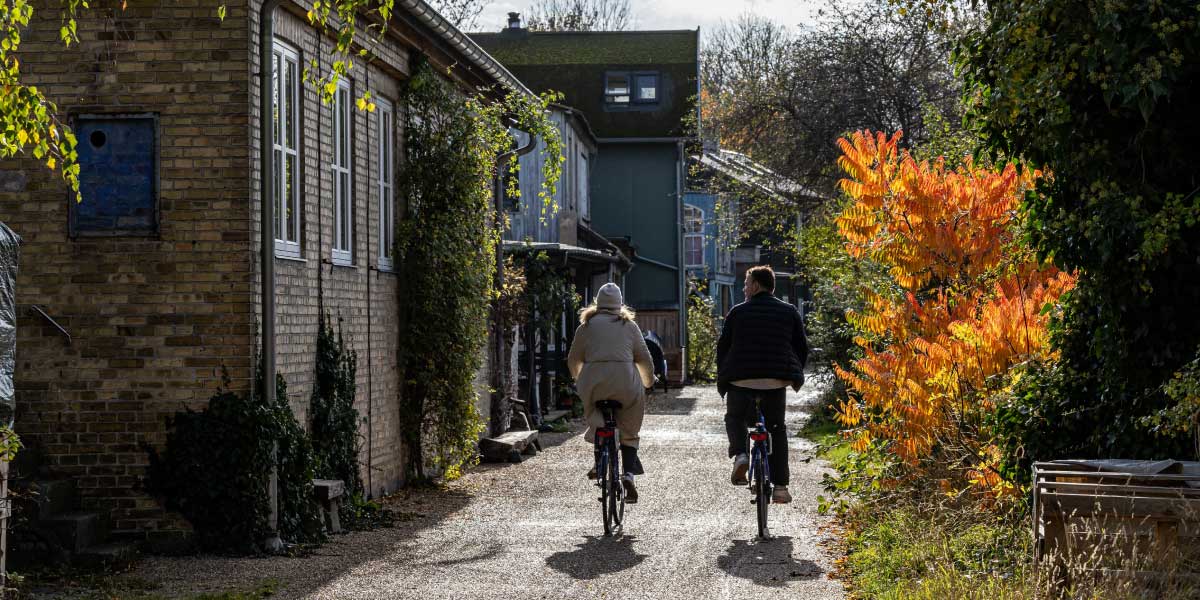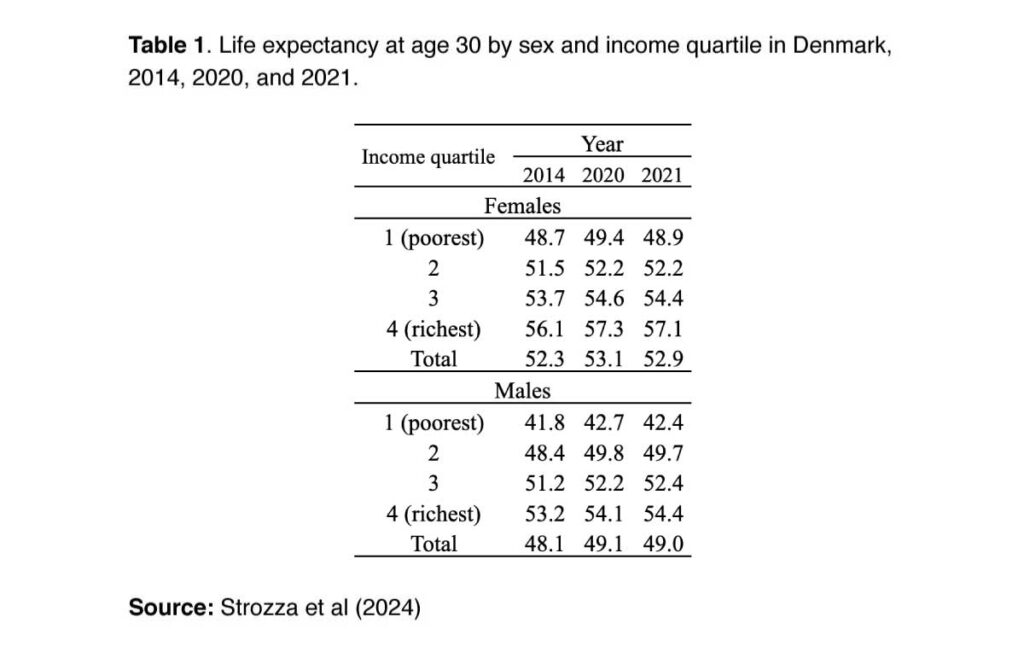Social inequalities in mortality expanded during the COVID-19 pandemic in Denmark. Cosmo Strozza, Serena Vigezzi, Julia Callaway, and José Manuel Aburto quantified life expectancy changes in 2020 and 2021 and underlying causes of death. COVID-19, as well as other causes, contributed to these changes.
The COVID-19 pandemic disrupted life expectancy trends in most high-income countries. In Denmark, while overall life expectancy returned to 2019 levels after the initial two pandemic years (2020 and 2021), this pattern was not observed across all the socioeconomic strata of the Danish population. Indeed, contrary to what many people outside the Nordic countries believe, large social inequalities in life expectancy persist in the Nordic countries (Brønnum-Hansen et al. 2021). In a recent publication (Strozza et al. 2024), using Danish registry data from 2014 to 2021 for all individuals aged 30 years and over, we investigated whether the COVID-19 pandemic magnified social inequalities in life expectancy in Denmark, and examined what causes of death contributed most to the observed changes.
Life expectancy changes during the COVID-19 pandemic
Life expectancy can be calculated in different years and at various ages. Table 1, for instance, shows life expectancy at 30 years at the beginning of the period and for the first two pandemic years by sex and income quartile, used as a proxy of socioeconomic status (SES).
Life expectancy is a snapshot of mortality conditions, and not a forecast of any individual’s lifespan. Therefore, its decline does not represent the number of years that will be deducted from the lifespans of individuals; rather, it provides a comparable measure of the impact of the mortality shock generated by the pandemic.
Table 1 shows yearly changes in life expectancy by sex and income quartile for the five years prior to the pandemic (2014-2019) and the initial two pandemic years (2020-2021).
Before the pandemic, yearly female life expectancy gains followed a social gradient. In other words, life expectancy was increasing faster for women in the highest socioeconomic groups than in the lowest. However, the confidence intervals shown in Figure 1 suggest that these results should be interpreted with caution. This was the case, to some extent, for men too, with the exception of the highest income group, where survival improvements were relatively limited. However, the differences in life expectancy changes were small, and the gap in life expectancy between the highest and lowest income groups remained large.
Figure 1 illustrates the Danish COVID-19 success story of 2020, when small gains in life expectancy were observed in the overall population (Aburto et al. 2021), as well as for most sub-populations, possibly due to the timing of policy interventions. However, the situation changed in 2021, and life expectancy losses were observed for the overall population (Schöley et al. 2022) and for most sub-populations.
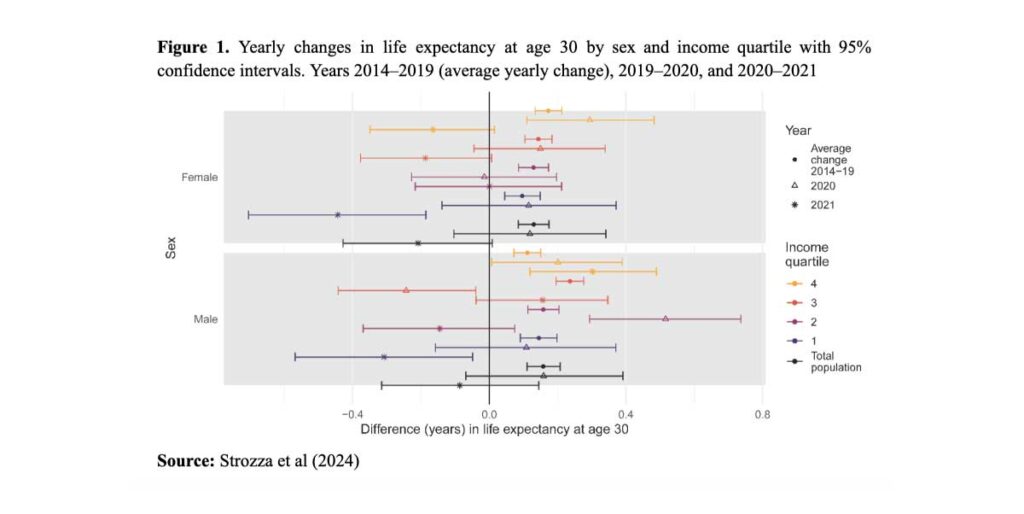
Focusing on 2021, we observe a social gradient in life expectancy changes for both men and women. Among women, all sub-populations experienced a loss in life expectancy, with those in the highest income group experiencing the smallest loss, less than two and a half months, compared to those in the lowest income group, who lost almost six months. Among men, those in the highest income groups experienced gains in life expectancy, while those in the lowest income groups experienced losses, the extent of which spanned from of almost four months gained to almost four months lost between 2020 and 2021. To summarize, inequalities in life expectancy increased across socioeconomic groups for both women and men. While the confidence intervals for the 2020 results mostly overlap, in 2021 this is the case for women but not for men, at least not when the top and the bottom quartiles are compared.
Causes of death contributing to changes in life expectancy
COVID-19 was not the only factor that contributed to changes in life expectancy over this period. Mortality from other leading causes of death changed too, illustrating socioeconomic inequalities in health caused indirectly by the pandemic.
Figures 2 and 3 show cause-specific contributions to changes in life expectancy at age 30 by income quartile for women and men, respectively. Note that individual year-on-year changes include random variability, and thus require caution in their interpretation. The positive trend in 2020 was due to a decrease in cardiovascular disease and cancer mortality across income quartiles, which counterbalanced the negative contributions of COVID-19. The smaller losses among women in the highest income group in 2021 were explained by decreases in cancer mortality and a smaller negative contribution of COVID-19 and residual causes. For those in the lowest income group, cancer mortality increased slightly, contributing to small negative changes in life expectancy. Slightly higher COVID-19 mortality, together with a high contribution from residual causes and infectious diseases accounted for the rest. Analyzing changes in other causes of death, in conjunction with COVID-19 deaths, gives a more complete picture of the indirect impacts of the pandemic.
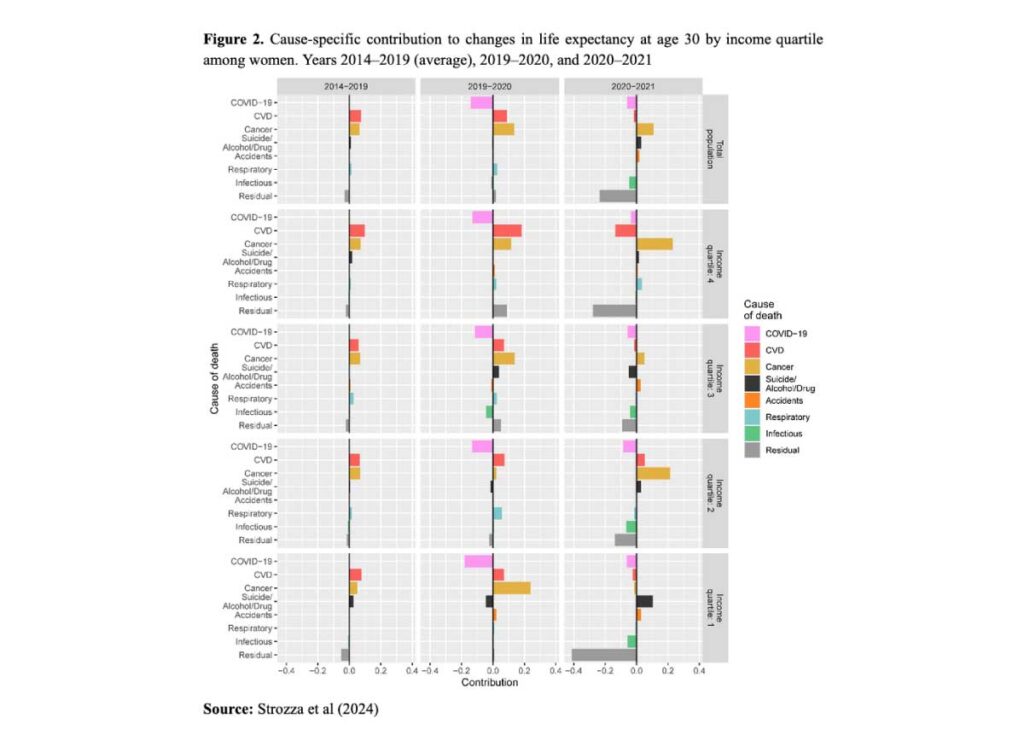
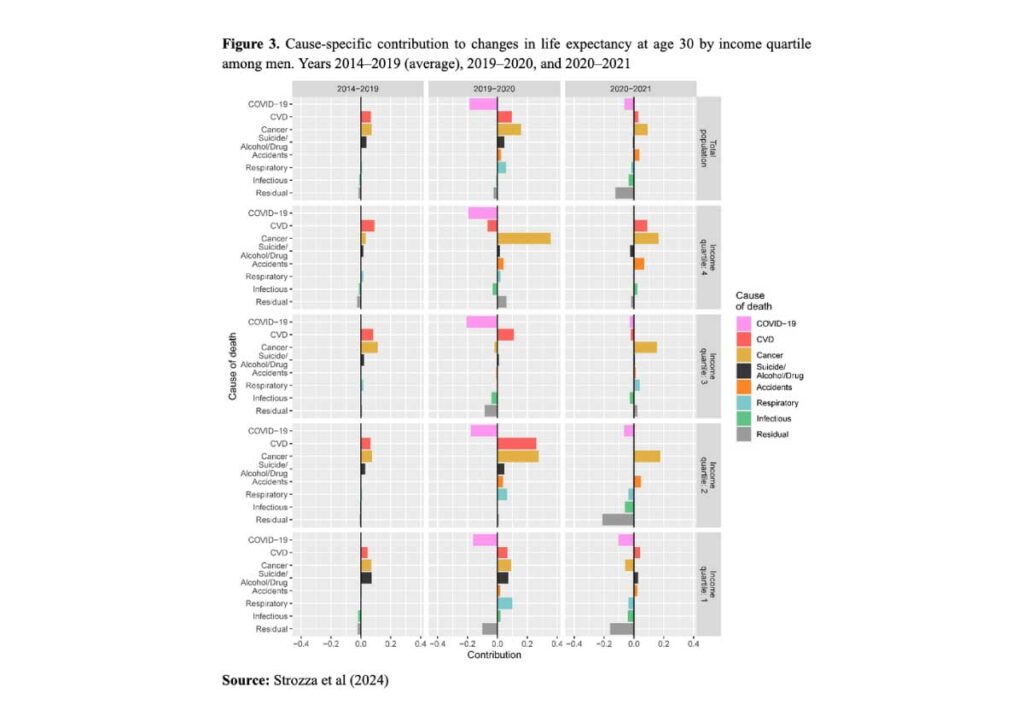
Among men, reductions in cardiovascular disease and cancer mortality also counteracted the emergence of COVID-19 in 2020, as they did for women, although other causes, such as accidents, deaths caused by suicide, drugs, or alcohol abuse, and deaths due to respiratory diseases had negative effects on changes in life expectancy in the lowest income groups. In 2021, cardiovascular disease and cancer mortality continued to decrease in high-income groups, leading to positive contributions to changes in life expectancy, while COVID-19 had practically no impact. Low-income groups, on the other hand, experienced increased mortality from COVID-19 as well as from respiratory diseases, infectious diseases, and other residual causes. For both women and men, this shows how the direct and indirect effects of COVID-19 contributed to the increasing life expectancy gap across socioeconomic groups.
Conclusions
Disparities in life expectancy across income groups in Denmark increased after the initial two pandemic years. The well-established mortality gaps were exacerbated by the dual impact of the pandemic, both directly through COVID-19 mortality, and indirectly through greater social inequalities in mortality from other causes of death. Our findings emphasize the critical need for more focused interventions for socially disadvantaged sub-groups during health emergencies. These interventions should not be restricted to the cause of the crisis itself, but are key to preventing a further widening of the gap between the most and least vulnerable sub-groups. Ultimately, this approach will foster a more equitable response to health crises.
References
Aburto JM, Schöley J, Kashnitsky I, Zhang L, Rahal C, Missov TI, et al. Quantifying impacts of the COVID-19 pandemic through life-expectancy losses: a population-level study of 29 countries. Int J Epidemiol. 2021;51(1):63-74. https://doi.org/10.1093/ije/dyab207
Brønnum-Hansen H, Östergren O, Tarkiainen L, Hermansen Å, Martikainen P, van der Wel KA, et al. Changes in life expectancy and lifespan variability by income quartiles in four Nordic countries: a study based on nationwide register data. BMJ Open. 2021;11(6): e048192. doi.org/10.1136/jech-2020-214108
Schöley J, Aburto JM, Kashnitsky I, Kniffka MS, Zhang L, Jaadla H, et al. Life expectancy changes since COVID-19. Nat Hum Behav. 2022;6(12):1649–59. doi.org/10.1038/s41562-022-01450-3
Strozza, C., Vigezzi, S., Callaway, J., and Aburto J.M. (2024). The impact of COVID-19 on life expectancy across socioeconomic groups in Denmark. Population Health Metrics 22, 3. doi.org/10.1186/s12963-024-00323-3


